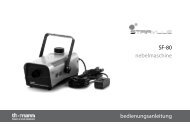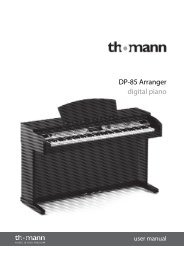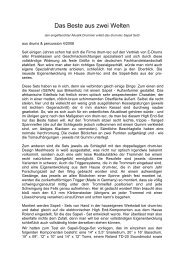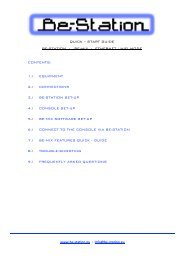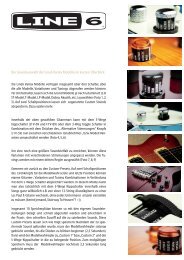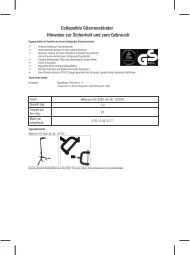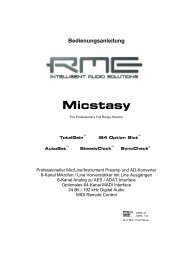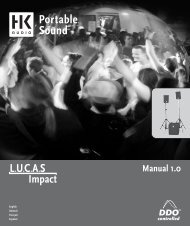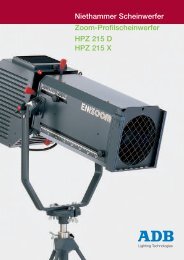Create successful ePaper yourself
Turn your PDF publications into a flip-book with our unique Google optimized e-Paper software.
5:7 Importing BFD 1.x Grooves and MIDI files<br />
Importing BFD 1.x Grooves and Bundles<br />
Groove formats<br />
BFD2 Groove files are stored in a proprietary format which allows the software to associate events with specific articulations, and<br />
are therefore independent of MIDI mappings. A Palette lets you assemble up to 128 Grooves, while a saved Palette also includes<br />
the state of the entire Grooves page.<br />
On the other hand, BFD 1.x used MIDI files as Grooves, routing notes to articulations according to the default BFD keymap. Up<br />
to 12 MIDI files were referenced from a text file called a Bundle file. The MIDI files exist in a subfolder with the same name as the<br />
Bundle file.<br />
These two formats are fundamentally different. The entire BFD 1.5 Groove library is provided with BFD2 as Palettes in the new<br />
format. Therefore, BFD 1.x Grooves and Bundles are not shown by default in the Palette. If you have any third-party BFD 1.5-format<br />
MIDI Grooves, or if you have made your own custom Grooves, BFD2 is capable of loading them.<br />
MIDI Import mapping<br />
Since BFD 1.x Grooves are in MIDI file format, with no internal articulation mapping, BFD2 must consult a MIDI keymap in order<br />
to assign its MIDI note events to articulations.<br />
The Import MIDI key map setting in the BFD2 Grooves preferences allows you to specify a keymap to use for importing MIDI<br />
Grooves.<br />
By default, BFD2 ignores any MIDI notes encountered that are not defined in the referenced keymap. A preference also exists<br />
(Unmapped MIDI note mode) to show a warning when this occurs instead of simply ignoring any unused notes.<br />
Accessing BFD 1.x Bundles in the Groove and Palette choosers<br />
1. Enable the Show BFD1 Bundles setting in the BFD2 Grooves preferences.<br />
2. Make sure the bundles and their constituent MIDI grooves are contained within a BFD 1.5 data path. BFD2 looks for Groove<br />
Bundles in BFD/Grooves, and for Fill Bundles in BFD/Fills. A Bundle must be usable in BFD to be loadable in BFD2. This<br />
means that it should properly reference up to 12 MIDI files inside a sub-folder of the Grooves folder with the same name as the<br />
Bundle. Check to see that the Bundle loads properly in BFD if you’re not sure!<br />
3. in the BFD2 Data preferences, click the Scan data paths for new files button.<br />
4. if the Grooves correspond to the BFD 1.5 keymap, set the Import MIDI map in the BFD2 Grooves preferences to use the BFD<br />
1.5 keymap provided with BFD2. If your Grooves are created for a different keymap, you’ll need to make a suitable new BFD2<br />
keymap – see chapter 8 for details of how to do this.<br />
The Palette and Groove choosers should now show the bundles and MIDI grooves, which are ready to load. Both Groove and Fill<br />
Bundles are shown in the chooser.<br />
Assembling Palettes from BFD1.5 bundles<br />
Groove Bundle sets generally consist of one or two Groove Bundles and an accompanying Fill Bundle, each consisting of up to<br />
12 MIDI files. In order to assemble these into a single BFD2 Palette, proceed as follows.<br />
1. Using the Palette chooser, load the first Groove Bundle. When loading a Bundle in this way, the Grooves are placed into ascending<br />
slots starting at C5.<br />
2. Using the Groove chooser on a suitable Groove slot in the Palette, with the Show Palettes button enabled, load all the Grooves<br />
contained within any other Groove and Fill Bundles in the set. Use the multiple selection capability in the chooser in order to<br />
accomplish this.<br />
3. If the set contains Fills, select them in the Palette and click the Fill button in the Slot Groove Actions area. These are now designated<br />
as Fills.<br />
4. Save the assembled Palette to the BFD2 User Grooves location.<br />
0



